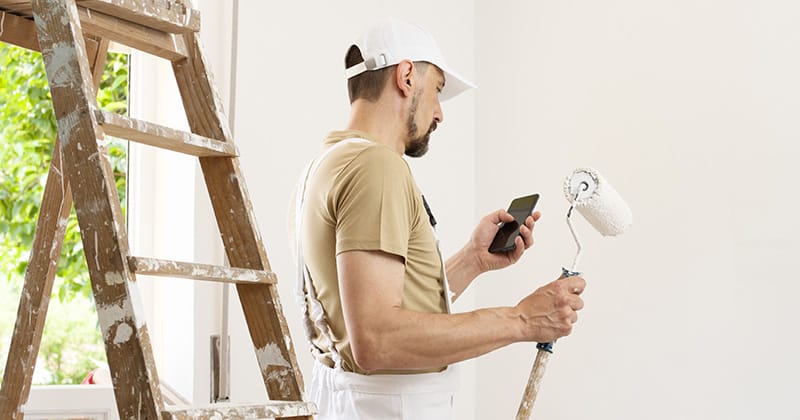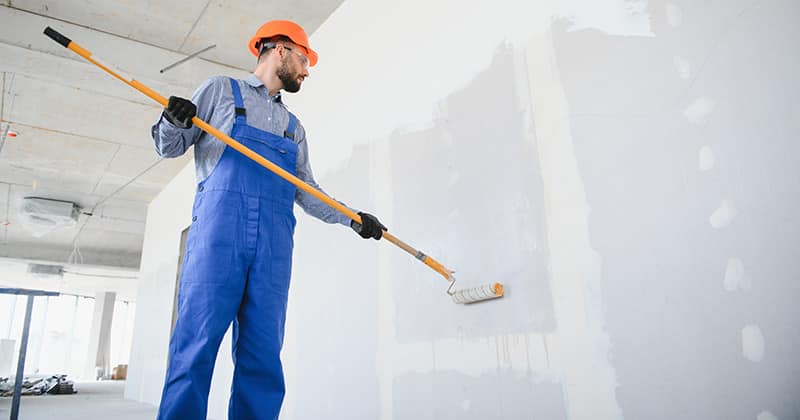The painting industry is growing rapidly. There is a lot of room for businesses to increase profit margins. Understanding how to balance expenses and profit can help make your business a success.
The painting industry is growing rapidly. With an expanding market, there is a lot of room for businesses to increase their profit margins. Despite these opportunities, turning a profit can still be a challenge.
Navigating the ins and outs of finance management can be overwhelming. Where do you save, and where do you invest? Figuring out how to increase revenue and decrease your overhead can be difficult.
Net profits for local painting companies can be anywhere from 12-30%. These profits vary because there are quite a few small expenses that begin to add up. Understanding how to balance this can help you maintain a profitable business.
This article explores the many expenses of running a painting company. You’ll also learn how to increase the profit margin to ensure a thriving business.
What Are the Average Expenses for Running a Painting Company in the US?

Painting companies have much more going on behind the scenes than just the painting project. Before you can really dig into how to increase your profit margin, you need to have a really good grasp on where your money is going.
There are a lot of working components of running a successful business. Many of the following expenses can vary widely. But they tend to be the most common expenses for a painting company.
Labor Costs
Small businesses spend most of their gross income on labor. As your painting business expands, this output will grow. Labor, including wages and benefits, can cost up to 40-50% of revenue.
Depending on your number of employees, these costs can spike. Hourly wages per employee can be anywhere from $15 to $34. This includes painters and any other staff.
Employee benefits cost an average of $11.86 per hour. This is around 30% of the total average cost per employee.
Materials and Supplies
To get the job done, you’ll need supplies. The various expenses on painting supplies can rack up a hefty receipt. Materials can cost about 15-20% of the job.
Paint itself costs quite a bit, anywhere from $15-60 per gallon. Higher-end paints can often be an added charge per project.
These expenses include paints, brushes, rollers, and drop cloths. Any other job-specific materials would also fall into this category.
Equipment Costs
Equipment can be a bit of an initial investment. This is for things like sprayers, ladders, scaffolding, and other necessary tools.
On average, painting companies can expect to spend $3,500 to $4,000 annually on equipment. This includes both purchase and maintenance.
Investing in quality equipment is well worth the price. It helps to ensure a safe and high-quality job.
Insurance
Insurance coverage is essential. It covers your employees, business, and the equipment you’ve invested so much in.
Costs vary depending on the size of your business. Small businesses often need a few different types of insurance.
Liability insurance costs minimally around $1,000 a year. It insures employees and any property damage.
Worker’s compensation insurance for painting contractors costs an average of $3,100. This price will depend on the number of employees that you have.
Commercial vehicle insurance should cost about $2,000 a year. Vehicle insurance will cover any company vehicle accidents or repairs.
Vehicle Expenses
Company cars offer a great opportunity for brand exposure and efficiency. However, they can be quite expensive.
The cost of a company vehicle splits between vehicle payments, repairs, and fuel prices.
Routine repairs and maintenance can cost an average of $0.09 per mile which can add up. If you drive 10,000 miles that’s $900 per year. Fuel prices vary from state to state, but they are a major contributor to the cost of running a vehicle.
In total, car ownership averages about $10,728 per year or $894 per month.
Advertising and Marketing
Marketing and advertising are essential for the growth of your company. Investing in marketing campaigns can help you attract new clients and build revenue. These expenses depend on how in-depth you want your efforts to be.
Marketing campaigns cover many bases. Campaigns can include traditional advertising, social media, digital ads, and email marketing.
Data shows that many business owners spend $5,000 to $15,000 monthly on marketing. Marketing can help your business maintain and build profitability. However, this amount can start small and build momentum as you gain clientele.
Licensing and Permits
Licensing fees vary by state. Depending on where you operate, they can cost a bit more. These fees range from $150-1,500.
It is illegal to work as an unlicensed contractor. You risk large fines if you don’t operate under the proper license. Paying the fee and getting the proper permits will help avoid fines and legal troubles.
Rent or Lease
Rental and lease spaces have a wide range of variables. The location, size, and condition of the building can affect prices. For example, if your company operates out of a home office, you’ll likely save a decent amount of money.
According to recent research, “the average US office listing rate stays at about a bit more than $38 per square foot per year”. This price depends on your location, but you can expect to pay around $1,200 a month for a 10,000 square-foot office.
Utilities
A physical location has more costs than just rent. Your business will need to allocate funds for utilities, too.
On average, you can expect utilities in a commercial space to cost $2.10 per square foot. Depending on location and square footage, that can range from $200 to $1,150 per month. Company phone services alone average around $200.
Fortunately, the benefits of a physical location can make the cost well worth it. It allows your business to expand, have safe storage for materials, and have space for administrative duties.
Taxes
A small business owner, on average, pays about 19% of gross income on taxes per year. Taxes changes based on many factors, such as proprietorship.
Small companies with one owner can expect a bit of a tax break. Companies with more than one owner can expect to pay a little more.
This amount varies by state and business size. However, the total percent paid should account for all applicable taxes. This includes property tax, sales tax, and income tax.
Legal and Professional Fees
Many business owners feel that accounting and legal paperwork are the worst part of owning a business. This side of business management is necessary but can be tedious.
Small businesses can outsource help in these areas. You can seek legal assistance to help with licenses, compliance, permits, and contracts. These services can cost between $180 and $440 per hour.
Accounting, especially, is essential. If this isn’t your specialty, don’t worry. You can contract out accounting services without emptying your wallet. Fifty-four percent of small business owners report spending $5,000 or less on accounting services per year.
Safety Equipment
Painting may not be the most dangerous job, but it has its risks. Your employees will need safety gear. This includes respirators, gloves, goggles, and any other protective equipment.
Most small businesses are spending around $1,300 per year on safety gear. This expense will depend on the number of employees and the type of safety equipment needed.
Office Supplies
Basic office supplies cost around $50-100 per employee monthly. Since most painting companies require minimal administrative work, this could save money.
The initial investment in office equipment is where you might end up spending more. Computers, printers, and various software can cost more.
Running a business that mostly operates out-of-office will cut expenses here. Being out in the field more means that you won’t need to invest much in setting up your office.
Maintenance and Repairs
Maintaining your equipment and vehicles is vital for a high-quality business. To get the job done, everything needs to work properly. Your painting business likely won’t need to spend much on repairs, but it may happen occasionally.
Company vehicle maintenance can cost around $1,456 per year. maintenance includes tires, oil changes, and general upkeep and repairs.
Equipment should be less than $1,000 per year. This number can be unpredictable, as sometimes accidents happen.
FROM ONE OF OUR PARTNERS: How to Analyze a Profit & Loss (P&L) Statement
How Much Should a Painting Company Spend on Marketing?

Investing in marketing is a great business move despite the cost. It brings in more leads and profit for your business. Increasing visibility helps reach new audiences.
Your marketing budget should cover expenses like advertising, social media, SEO, and lead generation.
Marketing strategies can’t guarantee results. But they do increase visibility. Many business owners are finding a high return on their investment.
Create a reputable and recognizable brand to help you stand out in a competitive industry. Investing in marketing may help boost business. Salesforce recommends spending 15% of your revenue on marketing.
FROM ONE OF OUR PARTNERS: Pricing for Profit
How Can You Differentiate Your Painting Business from Competitors in The Market?
Differentiation helps to distinguish your painting services from others. This tactic highlights the features of your business that stand out.
If your market is getting crowded, differentiate yourself. It will help your painting company build loyalty, sales, and growth. Incorporate a few of these ideas to get the ball rolling:
Guarantee Your Services.
Consider offering your customers guaranteed satisfaction on painting projects. Your business can ensure satisfaction with things like color, longevity of paint, or any other alterations.
Offering guaranteed services may help customers feel more confident choosing you. Building trust and respect will help make your business stand out.
Utilize lead generation services.
A lead generation service enables customers to seek leads through various online sources. Your painting company can partner with these lead services to send inquiries your way. Lead services are a great way to reach new clients and offer competitive pricing.
Many of these opportunities are pay-per-lead. So, if the services aren’t working for you, you won’t lose money.
You can find lead providers here.
Partner with local businesses.
Connect with other local businesses to build a partnership. Establish relationships with local contracting businesses, paint stores, and home improvement stores. Partnerships can help get your name out there and give you more referrals and a trusted reputation.
Train top-of-the-line employees.
Building relationships with customers starts with your employees. They’re the face of your business. They handle communications, projects, and everything in between.
Your employees should have the best customer service training. They should also be well-versed in the ethics of your business.
High-quality employees are far more likely to provide exceptional services.
7 Ways to Increase the Profitability of Your Painting Business

There are many ways to spend money while running a business. Fortunately, there are also many ways to save and to boost you profit margin.
Here are some tactics your business could use to increase profits:
1. Investigate the current market.
Researching your local market will help you remain competitive. Data can show you what other painting companies are offering. Then, you can adjust your business plan accordingly.
Research can show you current pricing, services, and untapped markets. This might reveal more opportunities to differentiate your business from competitors.
2. Analyze key performance indicators.
Key performance indicators (KPIs) are quantifiable measurements of success. They can help set milestones and gauge progress. Common KPIs measure revenue growth, client retention, and profit margin.
You can use KPIs to measure the profit margin of individual services. These stats will show you where you’re earning the most. This knowledge allows you to focus your energy there rather than overextending to areas that aren’t bringing in as much money.
3. Identify tax write-offs.
Running a company is expensive. It can feel like your business is bleeding money left and right.
Fortunately, many of these unavoidable expenses are tax write-offs. That means they are deductible from your yearly expenses, and you may get a bigger tax break.
Here’s a look at some tax write-off opportunities for commercial painters.
4. Use premium products and tools.
Using the best products will set your business apart. It may be a bit more of an initial investment, but it will likely pay for itself.
Higher-quality products help reduce the risk of having to return and fix anything. So even if your products are guaranteed, you won’t have to spend more time and money on touch-ups.
5. Try flat-rate pricing.
Flat-rate pricing will show your customers exactly what they can expect per project. This relieves any worry of last-minute markups or unexpected charges. It also saves time and money on estimates.
FROM ONE OF OUR PARTNERS: Flat Rate: The Pricing Method Contractors and Homeowners Prefer
6. Embrace virtual estimates.
Virtual painting estimates allow you to give quotes from your office. This can save time and resources.
This method works especially well if you’re utilizing flat-rate pricing. Rather than sending an employee to the site, you can send your clients a quote much faster.
This software can work in tandem with your estimators. You can always send an estimator to the site after your initial quote to ensure that there are no surprises.
7. Invest in business management technology.
Business management software can help save hours of administrative work. Many software solutions condense client files and orders into one place. This allows them to be accessed and updated in real-time.
How To Boost Painting Business Profits Immediately

Feeling anxious to start seeing more profit? Here are some steps you can take to start increasing profits—right now.
Set a solid budget.
Setting a firm budget ensures that you only spend on the necessary outputs.
Get familiar with your overhead and your revenue. Make sure that your expenses are reasonable in comparison to your income. If it isn’t, set a more frugal budget.
Register for Google My Business.
If you haven’t done so already, set up a free Google My Business account. This registers your business with Google so that you appear on Google Maps. Your business profile will also appear in local searches.
The account can also be developed to sell and market your services.
Ask for client reviews.
This is quick and easy. Email past clients and ask them to leave a review. Requests can also be made through your website.
Having client reviews is a free way to boost your company’s credibility. You can use these testimonials as marketing to attract more clients.
Tally up business expenses.
This one might feel like a chore, but knowing where your money is going is important. Check your bills and statements. Make sure that no extraneous expenses are going out every month.
Sometimes, things slip through the cracks. You may be spending money on things that are no longer necessary.

